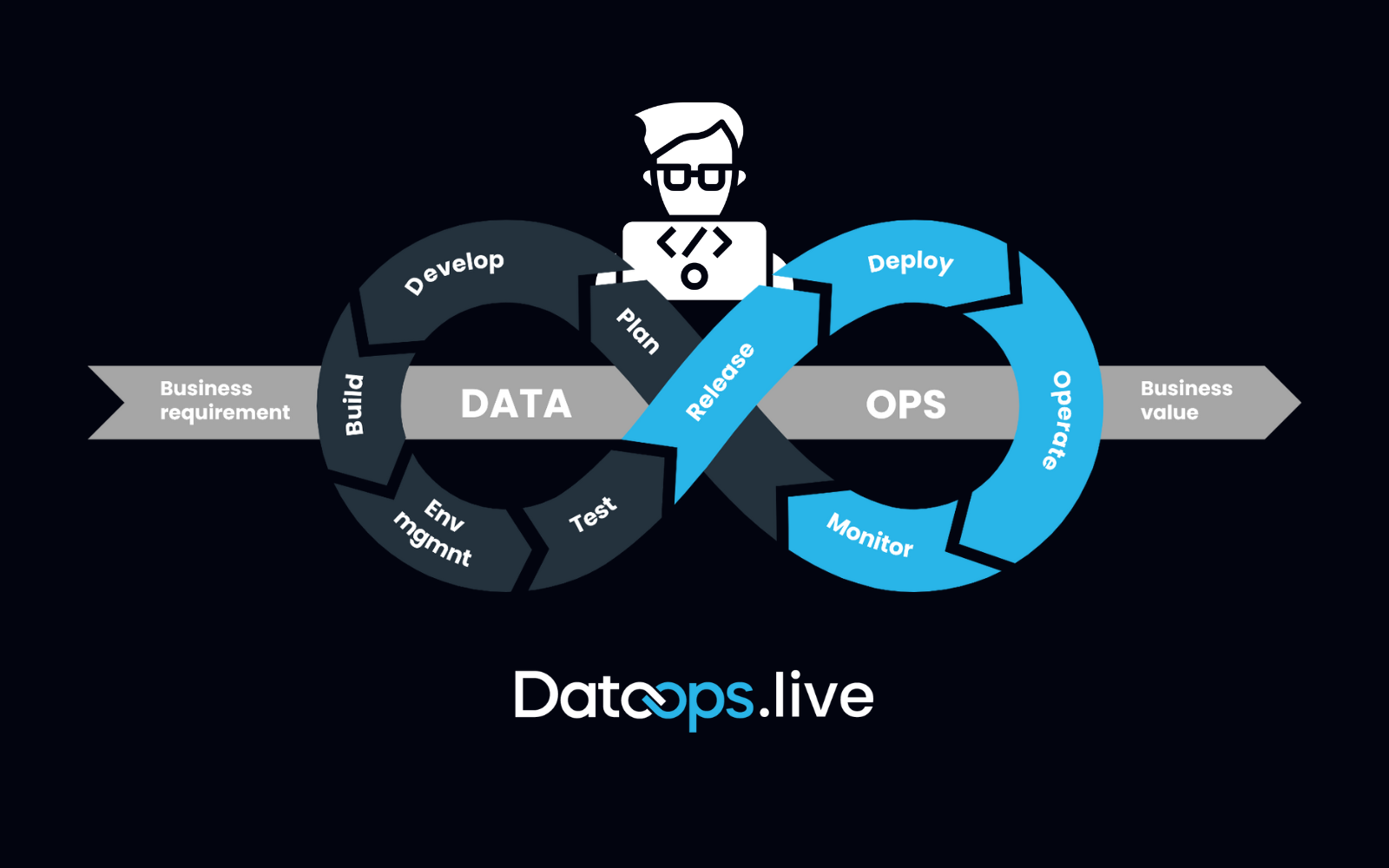AI accelerates DataOps — but only humans can guarantee its integrity.
A recent 80.lv article claimed Amazon replaced 40% of its AWS DevOps engineers with AI just days before an outage. Whether or not the story is accurate, it perfectly illustrates a fundamental truth: AI is powerful, but it isn’t ready to run critical systems without human control.
That’s why I often say:
AI is great on the left and right of the DevOps loop — but the middle still needs humans.
The DevOps Infinity Loop
.png?width=1820&height=558&name=image%20(18).png)
The infinity loop captures how ideas flow from business requirement to business value. On the left, we create value, planning, building, developing, testing. On the right, we realize it, releasing, deploying, operating, monitoring.
It’s continuous, circular, and collaborative, which is the same philosophy that underpins DataOps on the Snowflake Data Cloud. Iteration and governance are built into every step.
Where AI Shines — and Where It Struggles
AI is phenomenal at repetitive, low-judgment tasks. On the left side: code generation, documentation, and automated testing. On the right: monitoring, anomaly detection, and incident response.
But where AI struggles is confidence. It doesn’t yet give us the assurance that what it generates will behave the same way every time. Large-language models aren’t deterministic; they can produce subtly different results for the same input.
That’s fine for experimentation, but not for production systems — especially Snowflake workloads powering live data products and enterprise dashboards.
When I saw the AWS headline, I thought: plausible. Many companies are doing this — removing humans from the loop entirely. For trivial use cases, maybe that’s fine. But for critical systems that serve hundreds of Snowflake users and workloads, not yet.
AI can steer, but a human must still keep their hands on the wheel.
The Dangerous Middle
The “middle of the loop” is the deployment and pre-deployment zone — the handoff between AI-generated code and production. AI can act freely in development — that’s productive and safe. But once we move toward QA and production, nothing should pass through without human review. At least one, ideally two, human sign-offs should stand between automation and live execution.
AI still has a role here. One AI can build; another can challenge it, asking “how could this go wrong?” But the final accountability belongs to a named human being — someone willing to say “I approve this change.”
That’s doubly true for Snowflake environments, where deployments might trigger schema changes, budget-impacted compute, or Native App updates. Governance and human oversight are essential to protect downstream consumers and shared marketplaces.
Why Determinism Still Matters
The ability for code to behave exactly the same way every time (aka determinism) is foundational. Run the same process across dev, QA, and prod, and it should behave identically. If it doesn’t, testing becomes meaningless.
That’s why, in DataOps.live for Snowflake, even though AI helps generate configurations, what actually runs in the Snowflake pipelines is deterministic, repeatable, and human-approved. That’s how you build trust at scale across data products, workloads, and environments.
From Co-Pilots to Agents: The Human Role Evolves
We’ve shifted from co-pilot models (AI assisting humans) to agentic systems (AI taking initiative). With DataOps.live Momentum, we’ve embraced AI-centric processes with humans firmly in the loop.
Some organizations skip that last part — and that’s dangerous. Humans are still the governors of accountability. Even as AI becomes more deterministic and better at spotting issues, I still see the optimal model as multi-stage safety:
- One AI makes the change.
- Another, independent AI reviews it and writes a risk assessment.
- A human signs off the final version.
It’s similar to self-driving cars: they’re already statistically safer than human drivers, yet society still expects perfection. The same standard will apply to AI-driven DevOps—especially when those systems automate Snowflake compute, storage, or data product deployment.
People hold AIs to a higher standard than humans — and rightly so.
Real Examples in DataOps.live and Snowflake
We already have AIs that can build entire Snowflake-native data products from scratch based on a human’s description—models, tests, configurations, everything. But the human still decides whether to take it live; not by combing through SQL or YAML, but by reviewing outcomes:
- Does the Snowflake data product produce the expected dataset?
- Does the visualization align with the business intent?
- Does it meet cost and performance expectations under Snowflake’s compute model?
AI accelerates creation, but the human delivers assurance. The result is a faster, smarter Snowflake ecosystem, still governed by deterministic, human-approved configuration.
Lessons from the AWS Story
We’re not ready to let AI run critical systems alone. For non-critical, low-impact use cases with strong guardrails, maybe. But for Snowflake-powered data platforms and enterprise-grade pipelines, a human gatekeeper is essential.
If you’re a CTO under pressure to “AI-automate everything,” automate what makes sense. But don’t outsource accountability. When something breaks, it’s your responsibility, not the AI’s.
Part of a CTO’s job is to act as a safety net, to push back against hype-driven fads that risk reliability. If someone insists on full automation, ask them to sign the indemnity — and send them that AWS article.
At DataOps.live, our entire philosophy rests on that balance: automation, governance, and collaboration. Everything in a DataOps.live repository is human-readable and reviewable. Collaboration now includes AI components at every stage, from design to configuration to testing to monitoring, but the actual code executed in Snowflake pipelines remains deterministic and human-approved.
Automation everywhere — but governance and human sign-off at the core.
The Bottom Line
AI absolutely accelerates DataOps — and nowhere more than in the Snowflake ecosystem. It eliminates drudgery, enhances creativity, and boosts speed. But until AI becomes fully deterministic and accountable, there’s one rule that remains unbreakable:
AI accelerates DataOps — but only humans can guarantee its integrity.

 By
Guy Adams - CTO, DataOps.live
By
Guy Adams - CTO, DataOps.live




